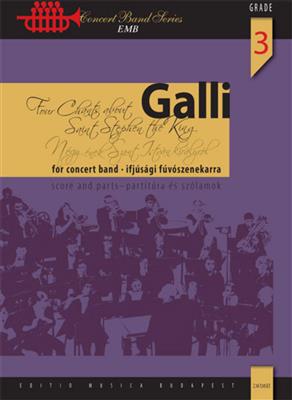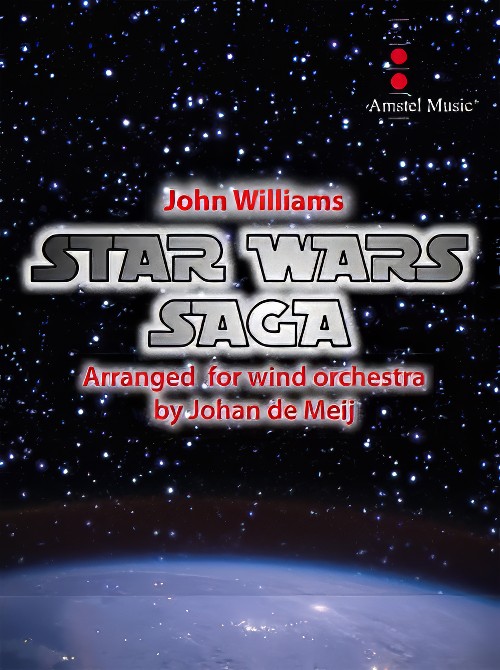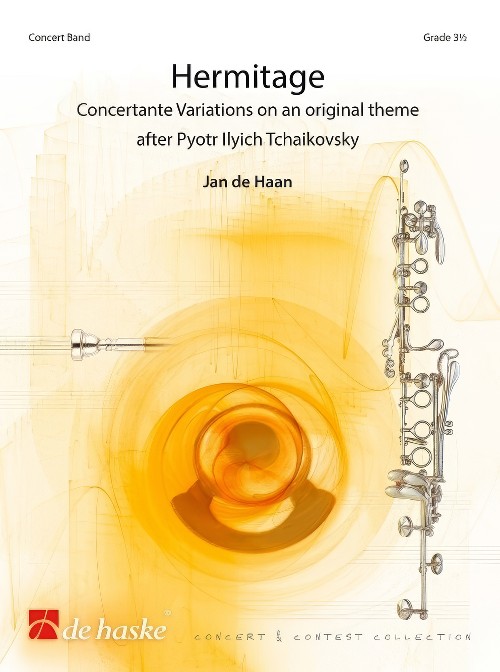Results
-
£109.99
Charanga For Trumpet - Boudewijn Cox
Boudewijn Cox is chiefly known as a Flemish composer in the modern classical music scene, but he has his roots in jazz.Charanga was a composition assignment from the "De Hoop" Ossendrecht music association and was created by Frank van der Poel in November 1999. Frank van der Poel, to whom this work is dedicated, is a well-known trumpet player and a renowned soloist who specialises in light music. He is also very esteemed as a big band lead trumpet.
Estimated dispatch 7-14 working days
-
 £154.60
£154.60Vise i vinterlys - Erik Bye
Erik Bye (1926-2004) was a major Norwegian TV-personality in his time, a colourful man with a varied background.He was a great lyricist, and many of his poems and songs have become modern Norwegian classics.This song, which could be translated at A ballad in Winter-light is maybe his only love-poem. He text describes a cold scene, where the lovers meet, and the images Bye paint are cold, bleak - but still with a warm intensity.The norwegian composer Egil Monn-Iversen (1928-2017) has brought a Scandinavian Noir feel to the text, they suit the lyrics perfectly.- John Philip Hannevik -
Estimated dispatch 7-14 working days
-
 £110.99
£110.99Dance of the Amazon - Anatoly K. Liadov
The Russian composer Anatoli Liadow was one of Rimski-Korsakov's talented students and was also a respected conductor. Liadow's compositions are relatively few, as he did not complete many of his works. One of the pieces he did complete was called Dance of the Amazon, which was written for the dancer Ida Rubinstein. Johan de Meij's arrangement makes this charming work, based on two Greek folk melodies, accessible to concert bands for the first time ever!
Estimated dispatch 7-14 working days
-
 £102.99
£102.99Cast Away (End Credits) - Alan Silvestri
In 2000, the movie Cast Away stormed into cinemas and received two Oscar nominations in the process. It follows the story of a man (played by Tom Hanks) who gets stranded on an island after the plane he is traveling on crashes. As the sole survivor, he does his best to keep himself alive while facing a rather bleak situation. An interesting feature about this film is that after hearing an Elvis song and a Russian choir, no music is heard again until the end of the movie, over 100 minutes later! Aidan Thomas creates a moving arrangement of the end credits music.
Estimated dispatch 7-14 working days
-
 £274.99
£274.99Symphony No. 2: States Of Mind, Opus 87 - Teo Aparicio-Barberán
I- Logos (reason)II- Pathos (emotion)III- Ethos (credibility)The ancient Greeks believed that music shaped the character of man. In Egyptian temples, music was an essential part of the magical rites to alter the course of nature or to treat illness.And today we know that sound can actually alter matter. The secret of music lies in harmony and mathematics, as many great musicians and experts have always known.One of the most important qualities of music is that it enables the listener to focushis attention inwards instead of on what is around him. It is indisputable that music can inspire emotion. Music leads us into a universe of emotions that are difficult to put into words. In short, music reaches into corners of our soul and thoughtsthat words cannot reach and makes it possible to more clearly describe these different States of mind.The composer of this symphony also believes that each "musical argument" must be constructed so that it will induce the desired reaction in thelistener.Music: more than wordsIn recent times, most orchestral symphonies have been based on a story, a text or something similar so that their composition must be structured accordingly.The intention of this work by Teo Aparicio-Barbern is quitedifferent. The composer describes the three elements of the argument as the only formal structure of the work. Since certain philosophers in world history were able to subdivide grammatical argument, why shouldnt that also be possible for the musicalargument?Since ancient times the power of the spoken word has captivated mankind. How can an argument move people and mobilise the masses? Where does the power of words come from today? The answer lays not so much in what people say but in how theysay it.Rhetoric is one of the oldest humanist disciplines in Western civilisation. Aristotle, in the 4th century BC, called it the art of persuasion. Indeed, the terms rhetoric and persuasion are mutually interchangeable.More than 2000 years agoAristotle structured his rhetoric according to the following three elements: the logos, the pathos and the ethos.Logos (words, reason) is the reasoning that gives freedom to the structure of the text by expressing what one wishes to say usingspecialist terms. With logos we create arguments to receive public approval and to defend our ideas.Pathos, the second element, refers to the effective use of public psychology. Pathos can be considered as the capacity to induce the desired emotionalresponse in the public, by creating an emotional connection with the public so that they accept our message.The third element, ethos (credibility), refers to the character of the speaker and is perhaps the most important of the three elements.Aristotle based his concept of ethos upon his belief that truth and justice will always have the upper hand over anger. He believed that what was true and good was easier to prove and was more persuasive.This second orchestral symphony from thecomposer from Enguera follows these three parameters of the argument according to Aristotle. Each movement tries to summon a different state of mind in the listener so that the message itself can be better understood and appreciated. Apart from thesethree general concepts the music is only structured, as Claude Debussy would say, in a "formative way".The first movement, logos, is based on a scherzo melody that undergoes various changes in rhythm and harmony. The arguments are presented by meansof conventional techniques of composition. The second movement, pathos, is characterised by suggestions of sound. It is subdivided into two large parts. The first part is based on a five seven sequence with five sounds that are repeated in differentenvironments, structures and dynamics. The second part, which is largely tonal, brings out more directly the emotional overtones that each argument must have. The third movement, ethos, is a faithful rendition of the composers personality. In thislast part, clear rhythmic sequences stand out, there are large dynamic contrasts and lots of tone variation. In addition, and this is quite in keeping with the composers earlier work, the harmony in States of Mind is handled in a manner that is bothoriginal and efficient, as a result of which Aparicio-Barberns message is well understood by the listener.This second symphony by Teo Aparicio-Barbern is devoted to "my dear Henrie Adams, a guiding light in this eternally dark musical world. Thankyou for everything."
Estimated dispatch 7-14 working days
-
 £159.99
£159.99Selections from Boris Godunov - Modest Mussorgsky
Composer Modest Moussorgsky (1839-1881) came from the prosperous environment of Russian nobility. In 1865, after his officer's education, he joined the guard's regiment in St. Petersburg. Here he met a number of well-known colleague-composers, including Balakirev, Cui, Rimsky- Korsakov and Borodin. They strived to develop a "classical style" of composing while at the same time retaining a strong Russian influence. His opera Boris Godunov tells the tale of Boris, who with the support of the people, declared himself Tsar, but totally fell short of the role. The opera became popular in the re-orchestrated version produced by Rimsky-Korsakov in 1896. Tohru Takahashi has usedthe beautiful musical themes of this opera in Selections from Boris Godunov - a captivating work for concert band.
Estimated dispatch 7-14 working days
-
 £118.99
£118.99The African sound of Bert Kaempfert - Bert Kaempfert
The composer, arranger and band leader Bert Kaempfert is considered a giant in the field of easy listening music. He wrote songs for world renowned stars such as Ella Fitzgerald, Peggy Lee, Shirley Bassey, Anita Kerr, Frank Sinatra and many others. He created his own unique sound with the Bert Kaempfert Orchestra and had huge international success. His affinity with 'black music' is significant and his fascination with South African sounds led to their incorporation into several of his compositions and arrangements. Roland Kernen has used the following well-known tunes in this medley: Zambesi, African Beat, Wimoweh, Happy Trumpeter and Skokiaan.
Estimated dispatch 7-14 working days
-
 £67.50
£67.50Four Chants about Saint Stephen the King
Jnos Galli (1921-2006) was a conductor, composer, music teacher, a well-known and highly respected personality in Hungarian wind music life. As a music teacher he directed numerous string and wind ensembles and choirs, made hundreds of transcriptions for wind orchestras, and instrumented works for ensembles of all sizes and formations. The most important of his works are his series of volumes of marches, folksong arrangements and church music. He was excellent at instrumentation. For its fine sound and easy playability we recommend to youth wind bands and their conductors this work of his composed in memory of the king who founded the Hungarian state.
Estimated dispatch 7-14 working days
-
 £129.99
£129.99Star Wars Saga (Concert Band - Score and Parts) - Williams, John - De Meij, Johan
John Williams (February 8, 1932) has composed some of the most popular, recognisable and critically acclaimed film scores in cinema history. Williams has won 25 Grammy Awards, five Academy Awards, seven British Academy Film Awards, and four Golden Globe Awards. With 53 Academy Award nominations, he is the second most-nominated individual, after Walt Disney. His compositions are considered the epitome of film music, and he is considered among the greatest composers in the history of cinema. His work has influenced many other composers of film, popular, and contemporary classical music. In 2005, the American Film Institute selected Williams's score to 1977's Star Wars as the greatest film score of all time. In this newly revised arrangement from 1986, arranger Johan de Meij has used themes from Star Wars: A New Hope and The Empire Strikes Back.
Estimated dispatch 7-14 working days
-
 £119.99
£119.99Hermitage (Concert Band - Score and Parts) - De Haan, Jan
Concertante Variations on an original theme after Pyotr Ilyich TchaikovskyJan de Haan drew inspiration for this work from five paintings exhibited in The Hermitage in Saint Petersburg, one of the largest and most versatile museums in the world. He used the melodious Andante cantabile from the String Quartet Op. 11 by the Russian composer Pyotr Ilyich Tchaikovsky as its starting point. Thus, he created his own musical painting, which is just as varied as the underlying canvases, from Cheerful Company by Dirck Hals to Dance II by Henri Matisse. A true work of art!Duration: 13.30
Estimated dispatch 7-14 working days
